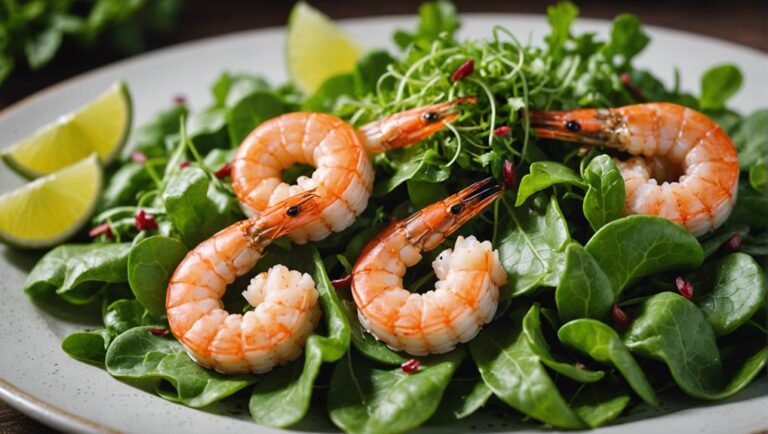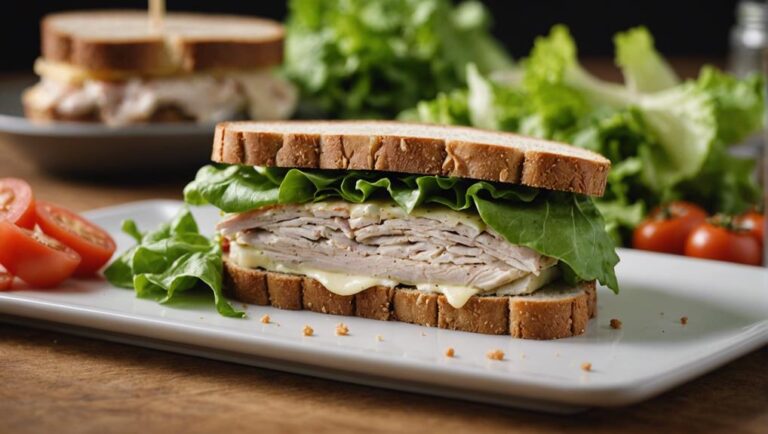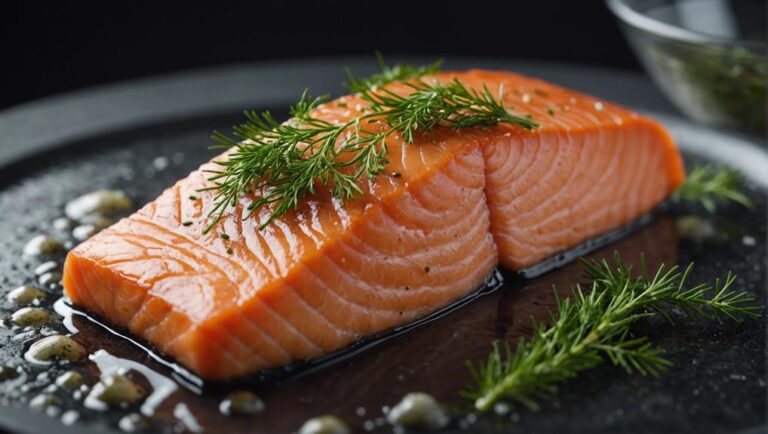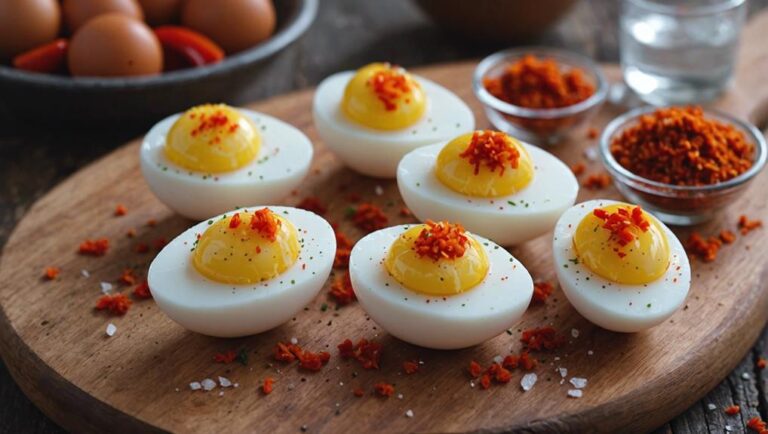Sous Vide Maple Pork Tenderloin With Mashed Potatoes
Indulge in a culinary masterpiece with Sous Vide Maple Pork Tenderloin With Mashed Potatoes. Seal the pork tenderloin with maple syrup, Dijon mustard, and apple cider vinegar for a symphony of flavors. Precision cooking in the sous vide guarantees juiciness and tenderness. Sear the pork for a perfect caramelized crust. Mashed potatoes provide a creamy and comforting accompaniment. This dish elevates your cooking skills and promises a gourmet experience. Get ready to impress your guests with this delectable meal that combines sweet and savory elements harmoniously. Discover the secrets of this exquisite recipe for a truly unforgettable dining experience.
What You Will Learn Here
- Sous vide cooking ensures precise temperature control for perfectly cooked pork tenderloin.
- Maple syrup adds a sweet glaze to the tenderloin, complementing the savory Dijon mustard.
- Mashed potatoes make a comforting side dish that pairs well with the flavorful pork.
- Utilize a well-seasoned cast iron skillet for caramelization and texture on the pork.
- Resting the pork after cooking enhances juiciness and flavor before serving.
Origin of Sous Vide

Sous vide cooking emerged in France during the 1970s, initially as a means to achieve consistent results with delicate foie gras. The technique, which involves vacuum-sealing food for precise cooking in a water bath, soon found favor in upscale dining establishments for its ability to guarantee moist, evenly cooked dishes.
As sous vide equipment became more accessible, its benefits of precise temperature control and professional-quality results have made it a popular choice for home cooks seeking culinary excellence.
Sous Vide Cooking Method
Originating in France during the 1970s, the sous vide cooking method revolutionized culinary techniques by introducing a precise and innovative approach to preparing food.
Sous vide involves vacuum-sealing ingredients like Pork Tenderloin, Maple Syrup, or Mashed Potatoes in a bag and cooking them in a temperature-controlled water bath. This meticulous Temperature Control guarantees even cooking and the desired doneness of your dishes.
By utilizing Vacuum-Sealing, flavors are locked in, resulting in tender, succulent meals. This cooking technique has become popular for its ability to consistently produce restaurant-quality dishes at home.
Sous vide isn't limited to specific food types, making it versatile for cooking a variety of ingredients to perfection every time.
Benefits of Sous Vide
The evolution of the sous vide cooking method has paved the way for a multitude of culinary benefits, enhancing the overall dining experience for home cooks and professional chefs alike.
Sous vide, which means 'under vacuum,' involves sealing food in vacuum sealer bags and cooking it in a water bath at a precise temperature. This technique allows for precise control over the cooking process, ensuring consistent results every time.
When cooking pork tenderloin sous vide, the meat retains its natural juices and flavors, resulting in a tender and succulent dish. Additionally, the sous vide method preserves the nutrients in the food, making it a healthier cooking option.
With sous vide, achieving restaurant-quality dishes at home has never been easier.
Sous Vide Equipment Needed
A precision cooker, vacuum sealer, and water bath are essential tools for successful sous vide cooking. When it comes to preparing a delectable pork tenderloin using the sous vide method, these pieces of equipment play an important role.
The vacuum sealer guarantees that the pork is securely sealed, preventing any moisture loss and allowing flavors to intensify. The precision cooker maintains the water bath at a constant temperature, ensuring precise control over the cooking process.
This method is particularly beneficial for pork tenderloin, as it results in a perfectly cooked, tender, and moist dish every time. By investing in the right sous vide equipment, you can elevate your cooking skills and enjoy consistent, restaurant-quality meals at home.
Pork Tenderloin Seasoning Varieties

Enhancing pork tenderloin with a diverse array of seasonings can elevate its flavor profile to new heights. When experimenting with seasoning variations, consider incorporating herbs like rosemary or thyme to introduce a unique taste profile.
Additionally, removing any excess fat or silver skin from the tenderloins before cooking is essential as it guarantees a better texture and flavor. To enhance the taste of the pork tenderloin, try different seasoning combinations to find the perfect match for your palate.
Remember, the sauce for the pork tenderloin can be adjusted post-cooking to suit your personal preferences and desired flavor profiles. By exploring different herbs, spices, and seasoning techniques, you can create a pork tenderloin dish that isn't only flavorful but also tailored to your liking.
Experimentation is key when it comes to seasoning pork tenderloin, so feel free to get creative in the kitchen!
Maple Mustard Sauce Recipe
The Maple Mustard Sauce Recipe is an essential element in elevating the flavors of your pork tenderloin.
With its blend of sweet maple syrup, tangy mustard, and aromatic herbs, this sauce adds depth and complexity to the dish.
Preparing this sauce ahead of time allows the flavors to meld, resulting in a delicious glaze for your sous vide-cooked pork tenderloin.
Sweet and Spicy Glaze
Infuse your sous vide pork tenderloin with a delectable blend of maple syrup, grainy mustard, and apple cider vinegar by preparing the sweet and spicy maple mustard sauce. This flavorful sauce adds complexity to the pork, enhancing its taste and aroma. The sweet and tangy balance of the maple mustard sauce complements the savory pork flavors perfectly. Brushing the sauce on the pork before searing infuses it with rich caramelized notes, elevating the dish to new heights. The versatility of the maple mustard sauce allows for customization based on personal preferences, whether you prefer a sweeter, tangier, or more balanced flavor profile.
- Enhances the taste and aroma of the sous vide pork tenderloin.
- Creates a perfect sweet and tangy balance.
- Offers versatility for adjusting to personal taste preferences.
Maple Mustard Glaze Recipe
For a delectable twist on your sous vide pork tenderloin, consider preparing the Maple Mustard Glaze Recipe, a balanced blend of grainy mustard, maple syrup, and cider vinegar that adds a sweet and tangy flavor profile.
- Versatile Flavors: The combination of Dijon mustard, maple syrup, and cider vinegar offers a unique blend of sweet and tangy notes that elevate the taste of the pork tenderloin.
- Enhanced Seasoning: By seasoning the glaze with salt, pepper, and herbs like sage or thyme, the overall taste profile is enriched, providing a more complex and flavorful experience.
- Caramelized Finish: When brushed onto the pork tenderloin before searing, the Maple Mustard Glaze creates a delicious caramelized crust that adds depth and texture to the dish.
Maple Mustard Glaze Instructions
Consider blending grainy mustard, Dijon, maple syrup, and apple cider vinegar to create a flavorful Maple Mustard Glaze for your sous vide pork tenderloin. Here's how to make the glaze:
- Mix Ingredients: Combine grainy mustard, Dijon mustard, maple syrup, and apple cider vinegar in a bowl. Adjust the ratios to suit your taste preferences.
- Coat the Pork: Generously apply the Maple Mustard Glaze to the pork tenderloin before searing it. Make sure the glaze covers the meat evenly for maximum flavor infusion.
- Enhance Flavors: Allowing the glaze to marinate on the pork before searing helps intensify the sweet and tangy notes, elevating the overall taste of the sous vide pork tenderloin.
Searing Pork Tenderloin Effectively
To sear pork tenderloin effectively, make sure your cast iron pan or grill is piping hot.
Searing for about a minute on each side creates a beautiful caramelized crust while keeping the meat tender.
Let the pork rest after searing to lock in juices and achieve that perfect balance of flavor and texture.
Searing Techniques
To accomplish a perfectly seared pork tenderloin after sous vide cooking, make sure your pan or grill is smoking hot before adding the meat. The key to a successful sear is the initial blast of heat to create that flavorful crust without overcooking the tender interior.
When searing your pork tenderloin, aim for about a minute on each side for that beautiful caramelized finish. This quick sear will lock in the juices and elevate the overall appearance and taste of your dish.
Remember to allow the seared pork tenderloin to rest before slicing to guarantee maximum juiciness and flavor retention. Mastering these searing techniques will take your sous vide pork tenderloin to the next level.
Best Cooking Tools
For searing pork tenderloin effectively, an essential tool to have in your kitchen arsenal is a well-seasoned cast iron pan. The cast iron skillet's ability to distribute heat evenly makes it perfect for achieving a flavorful crust on your pork tenderloin.
When using sous vide recipes, preheating the pan before searing the pork tenderloin is vital to getting that desired caramelization and texture on the outside. Searing not only enhances the taste but also locks in the juices, complementing the sous vide cooking method beautifully.
Invest in a quality cast iron skillet for your kitchen to make sure your pork tenderloin turns out perfectly seared and delicious every time.
Importance of Resting
Resting your pork tenderloin before searing is fundamental for maximizing flavor and juiciness in your sous vide maple pork dish. This essential step allows the juices to redistribute evenly throughout the meat, ensuring a flavorful and moist final result.
By giving the pork tenderloin a few minutes to rest, you allow it to finish cooking to the desired doneness while retaining its natural juices. Searing the rested pork tenderloin not only creates a delicious crust on the outside but also helps lock in the moisture, keeping the inside tender and juicy.
The combination of proper resting and effective searing is key to achieving a perfectly cooked sous vide maple pork tenderloin that's bursting with flavor and cooked to perfection.
Final Thoughts
In considering the overall success of the Sous Vide Maple Pork Tenderloin recipe, it becomes evident that the key lies in the balance of flavors and the meticulous attention to detail during the cooking process.
The combination of the savory Dijon mustard, sweet maple syrup, tangy apple cider vinegar, garlic, and herbs creates a harmonious flavor profile that enhances the natural taste of the pork tenderloin.
Cooking the tenderloin sous vide guarantees precise temperature control, resulting in a perfectly cooked and tender meat. Resting the pork after cooking allows the juices to redistribute, ensuring a juicy and succulent final dish.
Feedback from those who've tried this recipe highlights the importance of trimming excess fat or silver skin before cooking to improve texture and appearance. Additionally, experimenting with different herbs and seasonings can add a personal touch and elevate the overall flavor experience.
Frequently Asked Questions
Do You Sear Pork Tenderloin Before or After Sous Vide?
For ideal flavor development and texture comparison, sear the pork tenderloin after sous vide. This method offers precise control over searing benefits, juiciness factor, and temperature, ensuring a perfect finish without compromising the sous vide times.
How Long to Sous Vide Pork at 140 Degrees?
When sous viding pork at 140°F, aim for 1.5 to 4 hours for peak tenderness. Longer times can enhance texture, with 2 hours being a popular choice. Keep an eye on the sous vide equipment to maintain the precise temperature.
Does Pork Tenderloin Need to Be Seared Before Baking?
Searing benefits pork by enhancing flavor, locking in juices, and improving presentation. While not mandatory, searing is recommended for best taste and texture. Consider alternatives like reverse searing for different results. Experiment with temperatures and techniques for top-notch results.
Is It Better to Cook Pork Tenderloin Fast or Slow?
Slow cooking pork tenderloin is better for juicy texture, flavor infusion, and precise temperature control. High heat methods can lead to uneven cooking. Sous vide cooking guarantees the best results, retaining moisture and flavors.
Conclusion
Indulge in the succulent flavors of sous vide maple pork tenderloin with creamy mashed potatoes.
The tender pork, seasoned to perfection, is complemented by a sweet and tangy maple mustard sauce.
Searing the pork adds a delicious caramelized crust, enhancing the overall dining experience.
This dish is a perfect balance of flavors and textures, sure to impress even the most discerning palates.
Enjoy a gourmet meal from the comfort of your own home.











